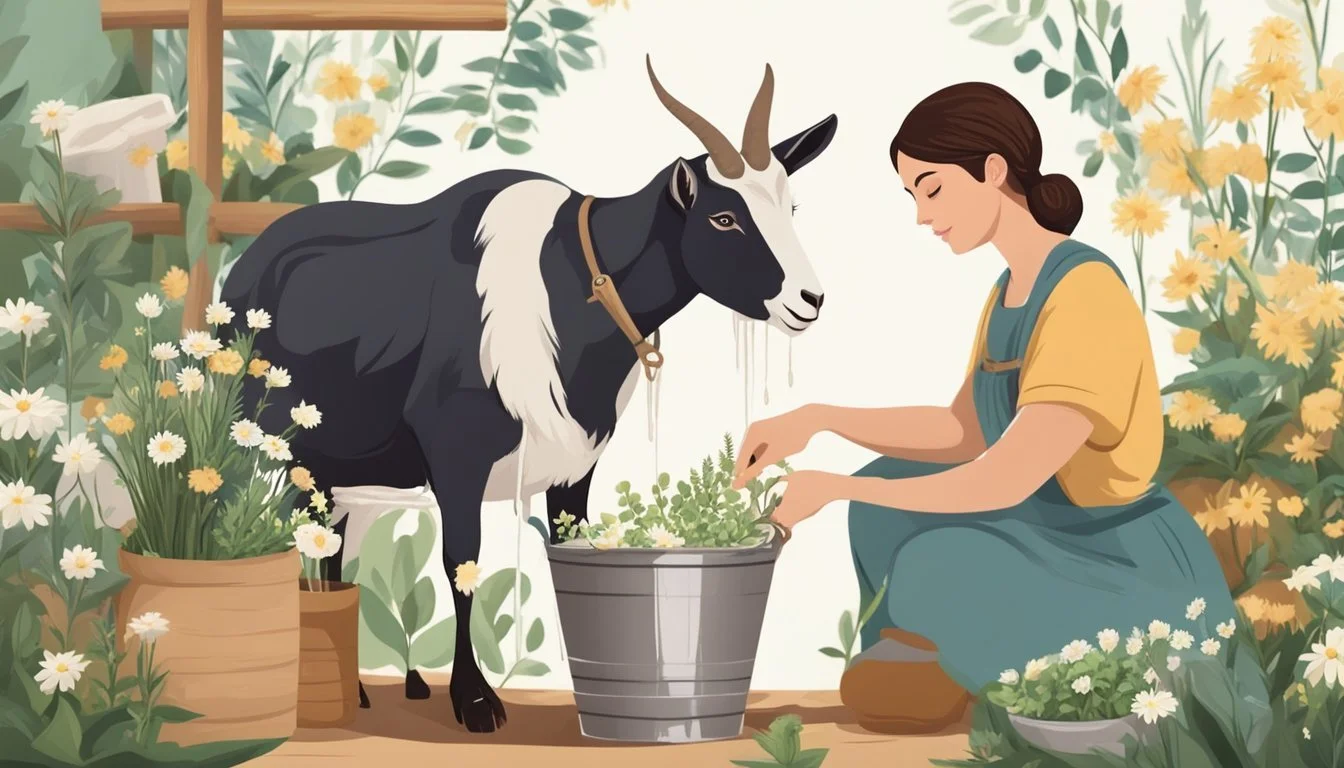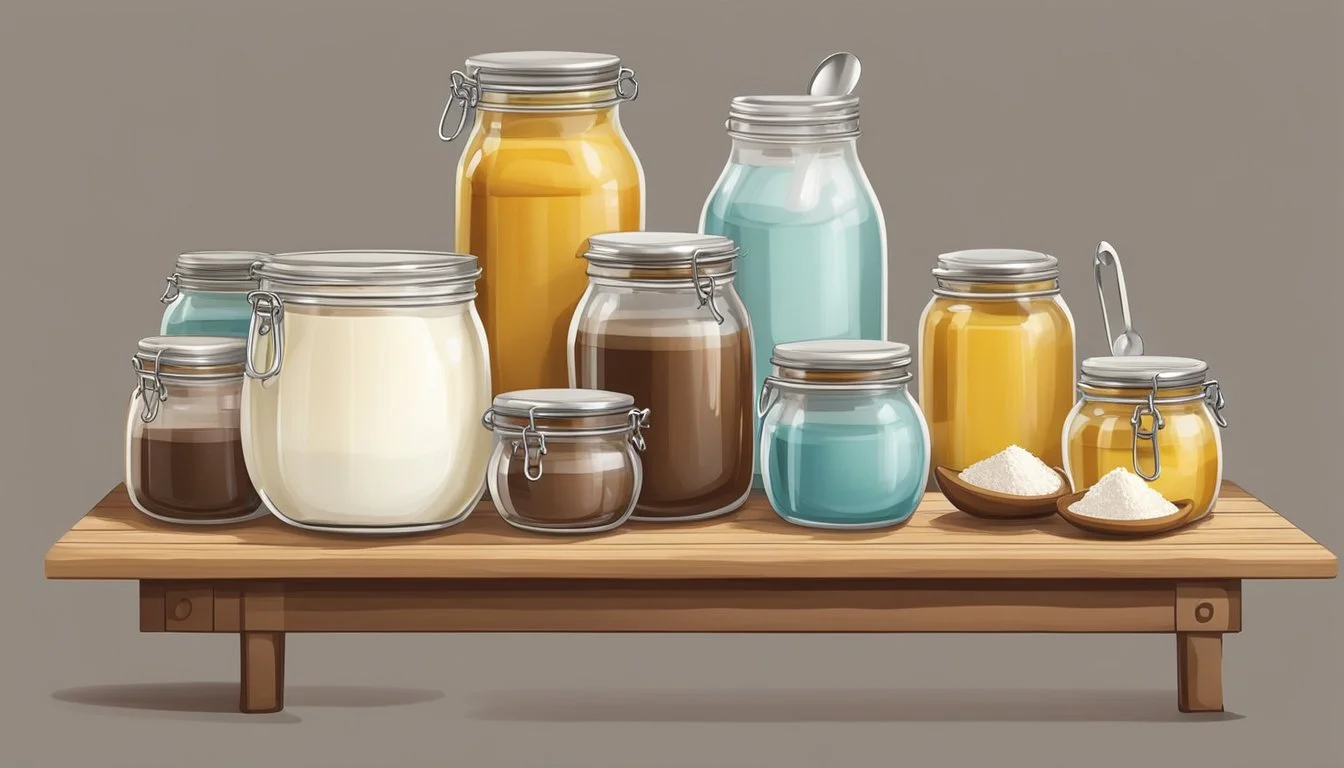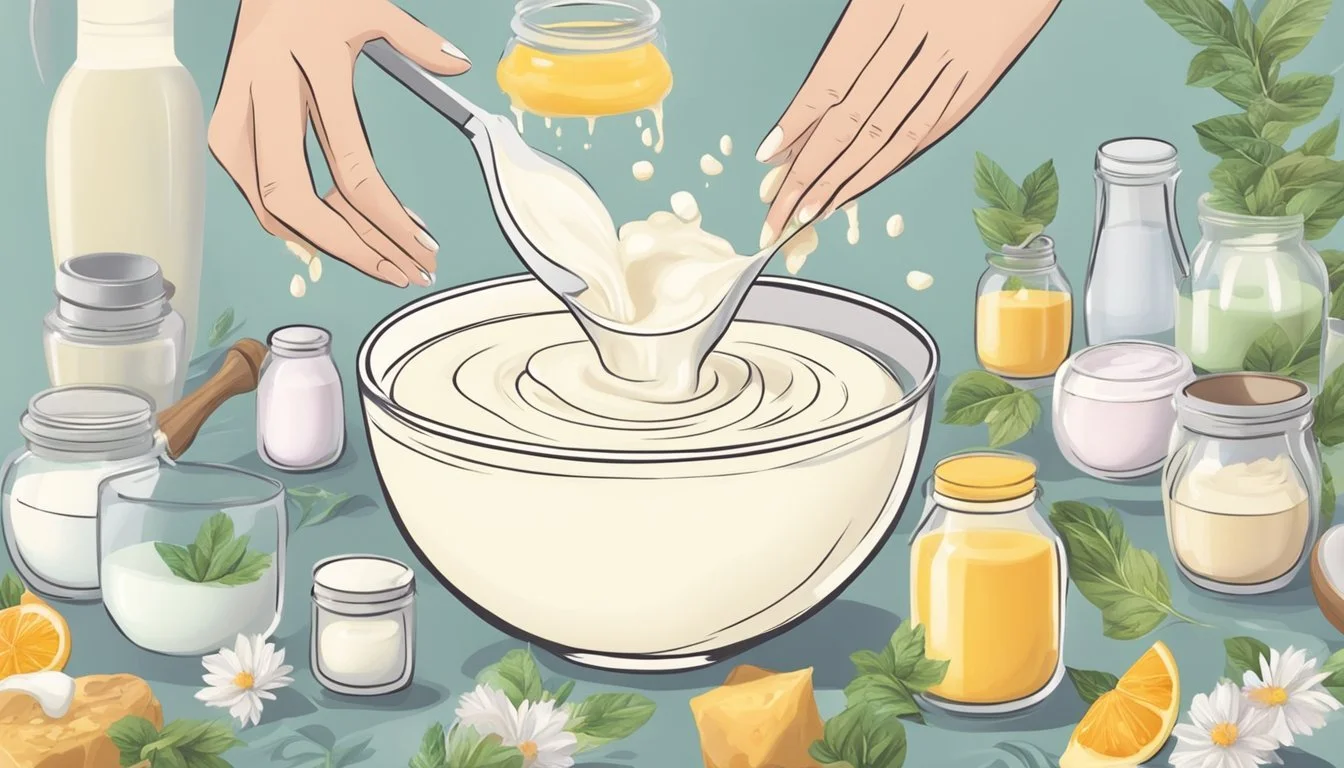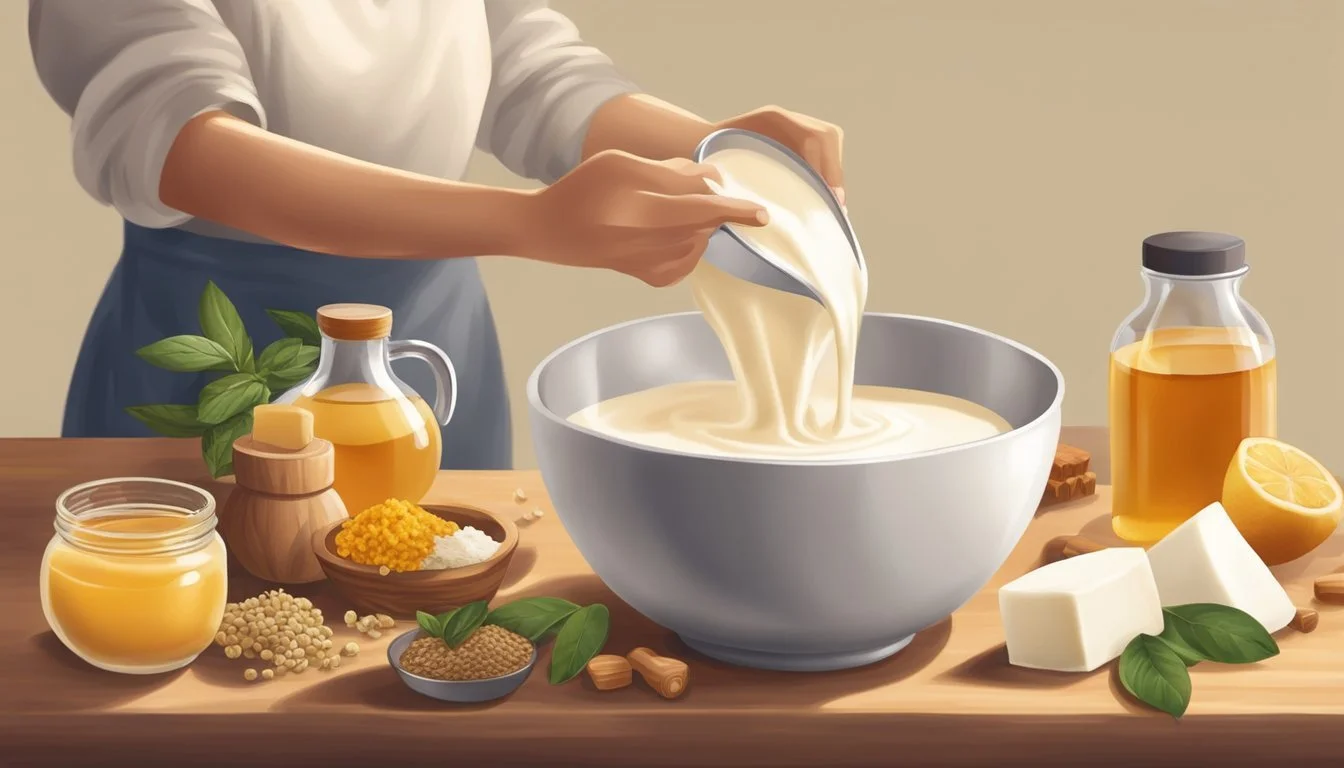Goat Milk for Skin Care
Crafting Luxurious Natural Lotions and Creams
Goat milk has been revered for its numerous benefits, especially in the realm of skin care. Its close pH balance to human skin makes goat milk an excellent ingredient for natural lotions and creams. These products aim to moisturize, soothe, and improve skin's overall appearance without the harsh chemicals found in many conventional beauty products. The mild and gentle nature of goat milk is suitable for people with sensitive skin, while its nutrient-rich profile offers a wealth of vitamins and minerals known to support skin health.
The process of creating goat milk lotions and creams often involves combining the milk with various natural oils, butter, and waxes. These elements work in synergy to enhance skin's hydration levels and provide a protective barrier. Crafting a DIY goat milk lotion for silky smooth skin not only allows individuals to tailor the recipe to their personal needs but also ensures the use of fresh, wholesome ingredients.
In the beauty industry, goat milk is quickly gaining popularity as consumers continue to seek out natural and effective skin care options. Its inclusion in homemade and artisanal beauty products underscores a commitment to purity and sustainability, appealing to a growing audience that values both personal health and environmental responsibility. As skin care trends evolve, goat milk stands out as a timeless ingredient with universal appeal.
Benefits of Goat Milk in Skincare
Goat milk is increasingly recognized for its skin-enhancing benefits, offering natural and nutrient-rich solutions for a variety of skincare challenges.
Hydrating Properties
Goat milk is highly regarded for its moisturizing abilities. Rich in fats and essential fatty acids, it provides deep hydration to the skin, without leaving behind a greasy residue. This natural moisturizer ensures the skin remains soft and supple.
Nutrient-Rich Composition
Packed with essential vitamins and minerals, goat milk nourishes the skin profoundly. It contains substantial levels of Vitamin A and various B vitamins, which are crucial for repairing skin and maintaining a healthy complexion. Minerals like selenium in goat milk also contribute to skin health.
Soothing Skin Conditions
For those with irritated skin, goat milk-based lotions and creams can be especially beneficial. Its composition can help soothe conditions like eczema, psoriasis, and acne, offering relief to inflamed and sensitive skin areas.
Natural Exfoliation
Lactic acid, an alpha hydroxy acid (AHA) present in goat milk, acts as a gentle exfoliant, helping to remove dead skin cells and promote new cell growth. This process can lead to brighter and more youthful-looking skin.
Anti-Inflammatory and Healing
Goat milk possesses anti-inflammatory properties which help to reduce skin irritation. The cream also aids in healing, thanks to antioxidants that protect the skin and contribute to its ability to soothe and heal damaged areas.
By incorporating goat milk into skincare routines, individuals may take advantage of these natural benefits to maintain healthy, vibrant skin.
Natural Ingredients for Goat Milk Lotions and Creams
Creating natural lotions and creams with goat milk as a base offers a wealth of skin-friendly benefits. Enriched with essential fatty acids and vitamins, these formulations help to moisturize and nurture the skin. Key natural ingredients play specific roles, enhancing the nourishing properties of goat milk skincare products.
Carrier Oils and Butters
Carrier oils and butters are fundamental to goat milk lotions and creams, serving as emollients that soften and hydrate the skin.
Coconut Oil: Provides deep moisturization and is known for its skin-conditioning properties.
Shea Butter: Highly nourishing, helping to address dry skin and maintain a smooth complexion.
Cocoa Butter: Acts as a protective barrier, locking in moisture and improving skin elasticity.
Mango Butter: Offers vitamins A and C, which soothe and promote youthful skin.
Avocado Oil: Rich in vitamins E and B, effectively hydrates and may aid in skin healing.
Sweet Almond Oil: Works well for most skin types and helps to cleanse the pores.
Jojoba Oil: Closely resembles human sebum, making it excellent for skin balance.
Essential Oils and Botanicals
Essential oils and botanicals provide scent and additional therapeutic properties to goat milk skincare formulations.
Lavender: Known for its calming and anti-inflammatory effects.
Frankincense: Believed to promote skin cell regeneration and improve skin tone.
Tea Tree: Offers antibacterial properties, making it good for acne-prone skin.
Grapefruit: Contains vitamin C and antioxidants supporting skin's natural clarity.
Rosemary Antioxidant Extract: Acts as a natural preservative and may improve blood circulation in the skin.
Natural Preservatives
Natural preservatives help extend the shelf life of homemade goat milk lotions and creams while maintaining their natural integrity.
Geogard ECT: A broad-spectrum preservative that's effective against bacteria, yeasts, and molds.
Grapefruit Seed Extract: Presumed to have antimicrobial properties, although its effectiveness is subject to product formulation and concentration.
Rosemary Antioxidant Extract: Not only enriches the product with antioxidants but also helps to preserve the oils in the formulation.
Linatural: A system combining various natural components often found in recognized preservative ingredient lists.
To craft effective and natural goat milk skincare products, it's essential to choose the right combination of these ingredients to suit specific skin concerns and preferences.
Equipment and Preparation
Crafting homemade lotion with goat milk is a rewarding do-it-yourself (DIY) beauty endeavor. The key to success lies in having the right tools, perfecting the blend, and understanding the importance of cleanliness and preservation to ensure a safe, natural, and effective product.
Tools Needed for DIY Lotions
For DIY enthusiasts looking to create their own natural beauty products, assembling the right equipment is crucial. The essential tools include:
Digital Scale: Precision is key, so all ingredients should be measured by weight.
Immersion Blender: This helps to thoroughly combine the oils and liquids.
Glass Measuring Cups: Necessary for accurate liquid measurements.
Double Boiler: Gently heats sensitive ingredients without scorching.
Spatulas and Spoons: Silicone or stainless steel tools for stirring and mixing.
Thermometer: Ensures temperatures are suitable for adding preservatives.
Pump Bottles or Jars: For storing the finished lotion, preferably dark glass to protect from light.
Creating the Perfect Blend
A well-blended product is essential for DIY beauty products, especially when it comes to lotion consistency and skin absorption. Guidelines for the blending process are:
Combine oils and butters with emulsifying wax, using a double boiler to melt the mixture.
Heat distilled water and goat milk separately to prevent bacterial growth.
Pour the heated water and milk into the oil-wax mixture while blending with an immersion blender until the lotion reaches a smooth consistency.
Monitor the temperature closely as it will dictate when to add preservatives for extending shelf life.
Sanitation and Preservation
Maintaining a sterile environment and using natural preservatives are vital steps to ensure the lotion is safe for use and has an adequate shelf life.
Sanitization: Clean all equipment with hot soapy water and disinfect with alcohol prior to use.
Preservation: Natural preservatives such as Populus Tremuloides Bark Extract can be incorporated to protect the product from bacterial growth. They should be added as per the recommended temperature and percentage guidelines.
Storage: Finished lotions should be stored in a cool place, preferably a refrigerator, to keep the active ingredients effective for as long as possible.
Remember, using a pump bottle not only helps in maintaining hygiene but also aids in the convenient application of your homemade lotion.
Step-by-Step Goat Milk Lotion Recipe
Creating your own goat milk lotion involves carefully selecting high-quality ingredients and following precise steps to blend them into a nourishing concoction for your skin. This DIY goat milk lotion recipe is designed to provide an enriching experience, delivering the benefits of goat milk, essential oils, and carrier oils directly to your skin.
Gathering Ingredients
Before beginning, one must gather the necessary ingredients, which ensure the lotion's effectiveness and stability. Essential items include:
Goat milk: A key component known for its hydrating properties
Carrier oils (such as coconut oil, avocado oil, or almond oil): They serve as the lotion's moisturizing base
Beeswax: Acts as an emulsifier, providing texture and thickness
Shea butter: Offers additional moisturizing benefits
Vitamin E oil: An antioxidant that can help to preserve the lotion and provide skin-nourishing effects
Essential oils (optional): For fragrance and added skin benefits
Preservative (to prolong shelf life): Required if the lotion will not be used quickly or stored in the refrigerator
One should measure each ingredient accurately, as precise ratios are critical for the lotion's consistency and shelf life.
Mixing and Blending Phases
The process of making goat milk lotion is methodical and requires attention to detail during both the heating and cooling phases.
Heating:
Melt the beeswax, carrier oils, and shea butter in a double boiler, stirring continuously until liquid.
Remove from the heat and let the mixture cool slightly before proceeding to the next step.
Cooling:
Stir in the goat milk gently but thoroughly to avoid clumping.
Add vitamin E oil and any desired essential oils, stirring to combine.
Continue to blend the ingredients, ensuring they are thoroughly mixed.
It's imperative to maintain the appropriate temperatures during these steps to optimize emulsion and to add preservatives and essential oils according to their heat sensitivity.
Storage and Usage
After blending, pour the lotion into a desired container, such as a pump bottle, which is convenient for dispensing and minimizes contaminants. Allow the lotion to cool completely before sealing the container. To preserve freshness, store the lotion in the refrigerator, as homemade lotions lack the strong preservatives found in commercial products. Refrigeration can extend the lotion's shelf life, typically ranging from a few weeks to a couple of months. Always label your lotion with the date it was made to track its lifespan. Regular usage can help maintain skin hydration and promote a healthy glow due to the natural benefits of the ingredients used in this goat milk lotion recipe.
Caring for Different Skin Types
When creating goat milk skin care products, one size does not fit all. It's important to tailor recipes and ingredients to cater to various skin types—ranging from sensitive to oily skin—and to address specific skin issues like acne or eczema.
Adapting Recipes for Specific Needs
Different skin types require unique care. For sensitive skin, it's essential to use mild, non-irritating ingredients. Goat milk is naturally gentle and can improve skin hydration. Those with oily skin may benefit from the addition of natural clays or light oils to help balance sebum production. Dry skin types thrive with the addition of rich, nourishing oils, such as coconut or shea butter, that are high in fatty acids and vitamin A found in goat milk which can help in moisturizing and rejuvenating the skin.
Sensitive Skin: Include soothing agents like aloe vera.
Oily Skin: Use clays or light oils to balance sebum.
Dry Skin: Add rich oils for extra hydration.
Addressing Skin Issues with Customizations
Goat milk lotions and creams can be fortified with specific ingredients to target certain skin concerns. For example:
Acne-Prone Skin: Integrate natural antibacterial agents like tea tree oil.
Mature Skin: Incorporate antioxidants such as vitamin E to aid in reducing the appearance of fine lines.
Eczema: Introduce oatmeal or honey to calm inflammation and soothe the skin.
Additives that could address skin issues include:
Acne: Additives for Customization - Tea tree oil, neem oil
Eczema: Additives for Customization - Oatmeal, honey, lavender oil
Inflammation: Additives for Customization - Chamomile extract, willow bark extract
Discoloration: Additives for Customization - Licorice root extract, kojic acid
Each ingredient serves a particular purpose and should be used in appropriate quantities to maintain the integrity of the goat milk product while benefiting the skin.
Troubleshooting Common Issues
In making goat milk lotion and creams, it is essential to address common issues that may arise regarding the consistency and preservation of the product to ensure a smooth, desirable texture.
Consistency and Texturing
Achieving the right consistency and texture in goat milk lotions and creams can be challenging. If the product is too thick, users can slowly incorporate a small amount of distilled water or goat milk until the desired smoothness is obtained. Conversely, if the lotion is too thin, additional natural thickeners like beeswax or shea butter can be melted and blended into the mixture. It's vital to add these ingredients gradually and test the texture after each addition.
Possible Issue: Lotion is too runny.
Solution: Gradually add small amounts of natural thickeners (i.e., beeswax).
Possible Issue: Lotion is too thick.
Solution: Incorporate distilled water or goat milk in small quantities.
Previously Failed Batches
Working with previously failed batches can be discouraging, but they can often be salvaged with the right approach. If the lotion has separated, it can sometimes be re-emulsified by gently heating the mixture and whisking it thoroughly. However, if the batch has an unpleasant smell or shows signs of mold, it should be discarded, as this indicates a failure in preservation.
Signs of Spoilage:
Smell: Development of an off-odour.
Visible Signs: Presence of mold or discolouration.
Solution: Discarding is essential as it compromises the safety and quality of the lotion.
For future batches, incorporating effective preservatives such as Populus tremuloides bark extract or neodefend can help extend the shelf life. Remember that natural preservatives have their limitations and lotions should be stored properly to prevent spoilage.
Advantages of Homemade over Store-Bought
Creating homemade goat milk lotions and creams offers several benefits that store-bought skincare products often can't match. These advantages include cost-saving measures, personalization of skincare formulas, and the absence of unwanted chemicals.
Cost-Effective Solutions
Homemade skincare concoctions, including goat milk-based lotions, can be significantly more cost-effective than their commercial counterparts. By sourcing natural ingredients in bulk or using home-produced goat milk, individuals can reduce the cost per batch. Comparatively, store-bought items often come with a heavy markup to cover branding, marketing, and retail distribution—as seen on platforms like Amazon.
Tailored Skincare
One of the most compelling reasons for choosing homemade over store-bought is the ability to tailor skincare products to one's unique skin type and preferences. Homemade lotion recipes allow for adjustments in ingredients and concentrations—ensuring that the product is just right for the individual's skin needs. This level of customization can help address specific skin concerns more effectively than a one-size-fits-all store-bought option.
Avoiding Harmful Additives
Many store-bought skincare products contain preservatives and other additives to prolong shelf life and enhance texture. Homemade goat milk lotions and creams offer a more natural alternative, free from these potentially harmful synthetic compounds. By controlling what goes into their skincare, individuals can avoid unwanted allergens and irritants, fostering a healthier, more natural skincare regime.
Further Considerations
When exploring goat milk's role in skin care, particularly in the creation of natural lotions and creams, two critical aspects merit discussion: the influence of market trends and consumer preferences, alongside the environmental impact and sustainability of goat milk products.
Market Trends and Consumer Preferences
The demand for goat milk in skin care has seen an upward trajectory as consumers increasingly seek products with perceived health benefits. Goat milk is not only known for its creamy texture but also for functioning as a humectant, which helps to retain moisture in the skin. As the public becomes more educated about the positives of goat milk, such as its gentle exfoliation properties due to lactic acid content, consumer preference is shifting towards these natural solutions.
Environmental Impact and Sustainability
The production of goat milk lotions and creams prompts consideration of sustainability and the environmental footprint left behind. Goat farming generally requires less land and produces fewer greenhouse gases compared to cow dairy farming, positioning goat milk as a more sustainable option. However, the sustainability of goat milk-based products also depends on factors such as the farming practices employed and the sourcing of supplementary ingredients.
Sustainable sourcing and ethical environmental practices are increasingly important to today's consumer, which directly affects the purchasing decisions within the market of natural skin care products.





